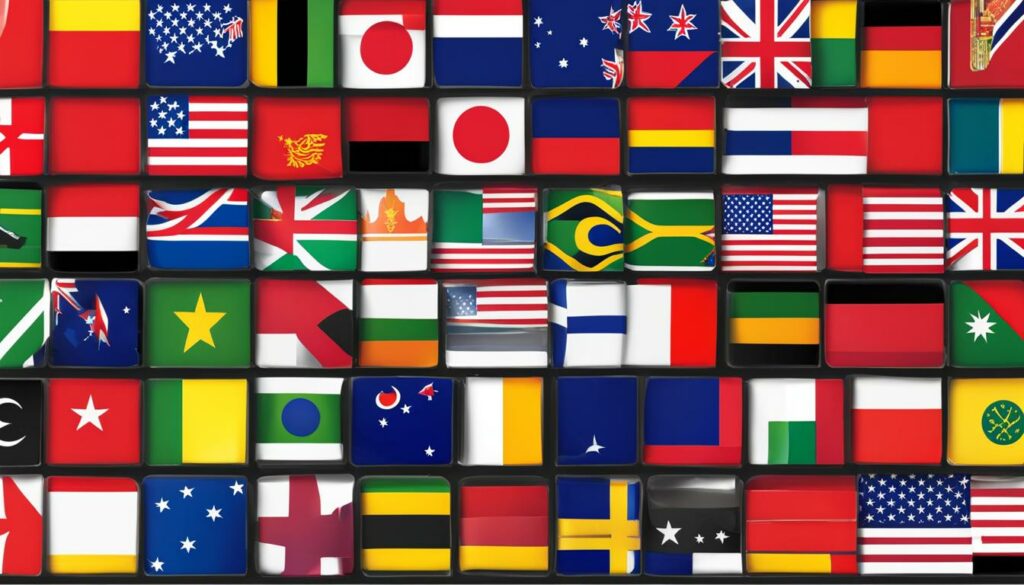Are you looking to expand your reach and attract a global audience? Creating a multilingual site with WordPress is the way to go. With WordPress Multilingual Sites, you can translate your content into multiple languages, allowing you to reach customers worldwide and increase your revenue.
To create a multilingual WordPress website, you’ll need a translation plugin specifically designed for WordPress. These plugins help you build a multilingual site with ease, providing features like language switcher plugins and multilingual SEO optimization.
Why should you choose a multilingual WordPress site? By offering content in different languages, you can improve the user experience and attract visitors from various countries. This, in turn, can boost your search engine rankings and increase your sales.
Before setting up your multilingual site, there are several key considerations to keep in mind. You need to carefully select the languages you want to support based on your target audience. It’s important to analyze the preferences and needs of your audience to ensure you’re providing content that resonates with them.
High-quality translations are also essential for a successful multilingual site. Automated translation tools may not provide the accuracy and nuance required. Consider using professional translators or trusted translation plugins to maintain the integrity of your content.
Consistent branding across languages is another crucial aspect. Your multilingual site should have a cohesive look and feel, regardless of the language. This helps build brand trust and recognition among your global audience.
With a wide range of translation plugins available, like WPML, Polylang, Weglot, or Google Language Translator, you can easily create a multilingual site with WordPress. These plugins offer various features and benefits, allowing you to customize your language switcher and manage translations efficiently.
Creating a multilingual site has numerous benefits for your business. It improves site traffic, increases sales, and gives you a competitive advantage in the global market. Additionally, it demonstrates your commitment to inclusivity and helps build trust with potential customers.
However, cultural considerations are crucial when creating a multilingual site. Not all words and phrases translate accurately, and understanding cultural nuances is essential. Make sure to avoid slang translations and ensure translation accuracy for a seamless user experience.
The URL structure for your multilingual site is an important factor for search engine rankings. Using dedicated URLs for each language version of a page and implementing hreflang annotations can improve search engine visibility and direct visitors to the appropriate language version.
Key Takeaways:
- Creating a multilingual site with WordPress can expand your reach and attract a global audience.
- Translation plugins like WPML, Polylang, Weglot, or Google Language Translator make it easy to create multilingual sites.
- A multilingual site improves user experience, boosts SEO, and fosters inclusivity.
- Select specific languages based on your target audience to allocate resources efficiently.
- Cultural considerations and accurate translations are crucial for creating an effective multilingual site.
We recommend WordPress Hosting from BoostedHost for optimal performance. Sign up now through this link to enhance your multilingual WordPress site.
Why Choose a Multi-Language WordPress Site?
Creating a multi-language WordPress site offers several benefits for your business. By expanding your global reach and offering content in multiple languages, you can connect with potential customers from around the world.
One of the key advantages of a multi-language site is the enhanced user experience it provides. When visitors can access your content in their preferred language, they are more likely to engage with your website, explore your products or services, and ultimately make a purchase. This not only improves their satisfaction but also increases the chances of repeat business and customer loyalty.
A multi-language site also has a positive impact on your page rankings and SEO efforts. When Google crawls and indexes your website, it can discover and rank additional pages in different languages. This results in higher visibility in search engine results and more opportunities to attract organic traffic.
Beyond the practical benefits, creating a multi-language site also demonstrates your commitment to cultural inclusivity. By accommodating different languages and cultures, you show that your brand is inclusive and welcomes everyone, regardless of their native language. This can help foster trust and build stronger relationships with your audience.
To illustrate the advantages of a multi-language WordPress site, consider the following table:
| Benefits | Description |
|---|---|
| Global Reach | Expand your audience and connect with potential customers in other countries. |
| User Experience | Provide a better experience for visitors by offering content in their preferred language. |
| Page Rankings | Increase the number of pages Google can crawl and improve visibility in search engine results. |
| Cultural Inclusivity | Show that your brand embraces diversity and welcomes people from different cultures. |
To create a powerful multi-language WordPress site, we recommend WordPress Hosting from BoostedHost. Sign up now through this link: www.boostedhost.com/wordpress-hosting.
“A multi-language site expands your reach, improves user experience, boosts SEO, and fosters cultural inclusivity. By investing in a multi-language WordPress site, you can truly make your brand global.”
Key Considerations Before Setting Up a Multi-Language Site
Before setting up a multi-language site, there are several key considerations to keep in mind. These include:
- Selecting the right languages based on your target audience. Conduct a thorough analysis of your target audience to understand their needs and preferences. Identify the languages that will best resonate with them and provide an optimal user experience.
- Ensuring high-quality translations by avoiding automated tools like Google Translate. Invest in professional translation services or use trusted translation plugins to ensure accurate and culturally appropriate translations.
- Maintaining consistent branding across languages. Your multi-language site should reflect your brand’s identity and values consistently in each language. This includes elements such as logo, colors, typography, and tone of voice.
- Choosing the right WordPress translation plugin to help you manage your multi-language site effectively. Consider popular options like WPML, Polylang, Weglot, or Google Language Translator. Evaluate their features, compatibility, and ease of use to find the best fit for your needs.

“Selecting the right languages, ensuring high-quality translations, maintaining consistent branding, and choosing the right WordPress translation plugin are essential for setting up a successful multi-language site.”
WordPress Translation Plugins for Multilingual Sites
When it comes to creating a multilingual site with WordPress, there are several translation plugins available that can make the process easier and more efficient. These plugins allow you to translate your site’s content into multiple languages, expanding your reach and connecting with a global audience. Let’s explore some of the popular WordPress translation plugins:
1. WPML (WordPress Multilingual Plugin)
WPML is a widely-used translation plugin that offers comprehensive multilingual support for your WordPress site. With WPML, you can easily translate your posts, pages, menus, and other website elements into multiple languages. It provides a user-friendly interface and allows you to manage translations efficiently. WPML also offers SEO-friendly URLs and provides compatibility with popular WordPress themes and plugins.
2. Polylang
Polylang is another reliable translation plugin that lets you create a multilingual site with ease. It supports the translation of various types of content, including custom post types and RTL scripts. Polylang provides a user-friendly interface, making it straightforward to manage translations for your site. It also offers language switchers, making it easy for visitors to switch between different language versions of your site.
3. Weglot
Weglot is a translation plugin that offers seamless integration with major WordPress themes. It provides an intuitive interface and enables you to translate your content into multiple languages effortlessly. Weglot also offers a customizable language switcher, allowing you to match your site’s design and branding. With automatic language detection and translation updates, Weglot ensures your translations are always up to date.
4. Google Language Translator
Google Language Translator is a widely-used translation service provider that offers a handy WordPress plugin. It allows you to translate different types of content, including posts, pages, categories, and tags. Google Language Translator provides a simple and straightforward setup, making it easy to integrate with your WordPress site. However, it’s important to note that this plugin relies on machine translation, so human editing may be necessary for accurate translations.
These WordPress translation plugins, including WPML, Polylang, Weglot, and Google Language Translator, offer unique features and benefits to help you create a multilingual site. Consider your specific requirements and preferences when choosing the right plugin for your WordPress site.
BoostedHost’s WordPress Hosting is an excellent choice for optimal performance. Sign up now through this link: www.boostedhost.com/wordpress-hosting.

The Benefits of Creating a Multilingual Site
Creating a multilingual site offers a multitude of benefits for your business. By translating your content into different languages, you can tap into new markets, increase site traffic, and drive sales. Let’s explore some of the key advantages:
Improved Site Traffic
Expanding your website’s reach beyond English speakers can significantly increase your site traffic. By catering to the preferences of non-English speaking users, you can attract visitors from different countries and cultures. This broader audience base can result in higher visibility on search engine pages, leading to more organic traffic to your site.
Increased Sales
A multilingual site opens up your business to a global customer base, allowing you to reach potential customers in their native languages. By providing content and product information in multiple languages, you remove language barriers and make your offerings more accessible. This enhanced accessibility can result in increased sales and revenue.
Competitive Advantage
Creating a multilingual site gives you a competitive edge in the global market. By expanding your reach and targeting new markets, you can stand out from your competitors and reach customers they may not be able to reach. This advantage can lead to increased customer acquisition and market dominance in new territories.
Better Brand Trust
Offering a familiar experience in the native language of your potential customers builds trust and credibility. A multilingual site shows that you value and respect different cultures, making it more likely for users to trust your brand and make a purchase. This trust can lead to long-term customer loyalty and positive word-of-mouth recommendations.
With the benefits of improved site traffic, increased sales, competitive advantage, and better brand trust, creating a multilingual site can be a valuable investment in the growth and success of your business.
Cultural Considerations for Multilingual Sites
When creating a multilingual site, it’s crucial to take cultural considerations into account. Translating every word or phrase may not always yield the desired effect, as languages have unique nuances that may not directly translate. Understanding these cultural differences is essential to ensure that your content resonates effectively with your target audience.
To maintain translation accuracy, it’s advisable to steer clear of automated translation tools. Instead, opt for professional translation services or trusted translation plugins that can guarantee accurate and high-quality translations for your website.
In addition to accurate translation, it’s important to be mindful of slang translations. Slang varies greatly across languages and regions, and a direct translation may not convey the intended meaning. Adapting your content to include slang translations that are specific to your target audience will help create a more authentic and relatable experience.
QUOTES
“Language is the road map of a culture. It tells you where its people come from and where they are going.” – Rita Mae Brown
By considering cultural differences and tailoring your language translations accordingly, you can create a multilingual site that not only speaks to your audience but also fosters a sense of connection and inclusivity.

List of Cultural Considerations:
- Understand cultural nuances and adapt translations accordingly
- Avoid relying solely on automated translation tools
- Use professional translation services or trusted translation plugins
- Be mindful of slang translations and adapt content accordingly
By taking cultural considerations into account, you can ensure that your multilingual site is culturally sensitive, accurately translated, and resonates with your diverse audience.
URL Structure for Multilingual Sites
When it comes to creating a multilingual site, the URL structure plays a crucial role in ensuring proper recognition and ranking by search engines. Instead of relying on cookies or browser settings, it is recommended to use dedicated URLs for each language version of a page. This approach allows search engines to understand and index the different language versions of your content accurately.
Implementing a clear and optimized URL structure offers several benefits for your multilingual site. Firstly, it improves search engine rankings by providing search engines with the necessary information to determine the relevance of your content to the user’s search query. Secondly, it enhances the user experience by making it easier for visitors to navigate between language versions of your site.
One useful technique is to include the language code in the URL. For example, if your primary language is English and you also offer a Spanish version, you can use the following structure: www.example.com/en/ for English and www.example.com/es/ for Spanish.
Furthermore, hreflang annotations can be added to the HTML header of each page to guide search engines towards the most appropriate language version for a given user’s location. This helps search engines understand the language targeting of your content and ensures that visitors are directed to the version that matches their language preference.
Localized versions of your site can also be included in subdomains or subdirectories. For example: en.example.com or example.com/en/ for the English version, and es.example.com or example.com/es/ for the Spanish version. This structure is particularly effective when targeting specific geographical regions.
To illustrate the importance of URL structure for multilingual sites, here is a comparison of two different URL approaches:
| URL Structure | SEO Effectiveness | User-Friendliness |
|---|---|---|
| www.example.com/page | Good | May cause confusion for users trying to access different language versions. |
| www.example.com/en/page | Excellent | Clear and easy for users to navigate between language versions. |
As you can see, having a dedicated URL structure for each language version not only improves search engine rankings but also enhances the user experience. This ultimately leads to better engagement, higher conversion rates, and increased customer satisfaction.
With an optimized URL structure in place, you can boost your multilingual site’s visibility in search engine results and provide a seamless experience for your global audience.
Selecting Specific Languages for Your Multilingual Site
When creating a multilingual site, it’s important to select specific languages that align with your target market and audience. Instead of developing a website in every possible language, focus on identifying the most common languages among your target audience. This approach allows you to allocate your resources efficiently and create a more targeted and effective multilingual site.
Consider the demographics, preferences, and needs of your target audience to make informed decisions about language selection. Conduct market research to understand which languages are spoken by your target market. Analyze data such as language prevalence, population distribution, and customer insights to guide your language selection process. By choosing the languages that are most relevant to your audience, you can create a multilingual site that resonates with your users.
Remember that language selection goes beyond mere translation. It involves understanding the cultural context, idiomatic expressions, and regional nuances associated with each language. Consider partnering with professional translators or linguists who specialize in the languages you are targeting. Their expertise can help ensure that your content is accurately translated and culturally appropriate for your target audience.
To further optimize your language selection, prioritize languages that align with the efficient use of resources. Evaluate factors such as market size, revenue potential, and cost-effectiveness. For example, if your target market consists of predominantly English and Spanish speakers, it would make sense to focus on translating your website into these two languages initially.
By selecting specific languages based on your target market and audience, you can create a multilingual site that effectively reaches your desired audience and maximizes your resources.
Consider the following table, which highlights the top five languages spoken worldwide:
| Language | Approximate Number of Speakers |
|---|---|
| Chinese (Mandarin) | 1.3 billion |
| Spanish | 460 million |
| English | 360 million |
| Hindi | 341 million |
| Arabic | 315 million |
Best Practices for Multilingual Sites
To ensure the success of your multilingual site, it is important to follow some best practices. Taking into consideration cultural differences and adapting your content and language choices accordingly can greatly enhance the user experience. Additionally, utilizing dedicated URLs for each language version of a page can improve search engine rankings and provide a seamless browsing experience. When selecting specific languages, it is crucial to consider your target market and audience to maximize the efficient use of your resources.
- Consider cultural differences: Cultural nuances play a significant role in effective communication. Be aware of cultural differences in language usage, idioms, and preferences to ensure your message is well-received.
- Use dedicated URLs: Implementing dedicated URLs for each language version of a page helps search engines recognize and rank your content accurately. It also allows users to easily switch between languages and find the most relevant information.
- Select specific languages: Take the time to identify the specific languages that will resonate most with your target market and audience. By focusing on the languages that matter most to your audience, you can allocate your resources more efficiently and create a more impactful multilingual site.
By adhering to these best practices, you can create a successful and effective multilingual site that caters to the unique needs and preferences of your diverse audience.
BoostedHost WordPress Hosting
Looking for the perfect hosting solution for your multilingual WordPress site? BoostedHost offers high-performance WordPress Hosting optimized for optimal site speed and reliability. Sign up now through this link to get started!
Conclusion
Unlock the tremendous potential of a global audience by creating a multilingual site with WordPress. With its wide range of translation plugins like WPML, Polylang, Weglot, or Google Language Translator, WordPress makes it easier than ever to reach a global audience and expand your online presence.
By translating your content into multiple languages, you can greatly improve the user experience for international visitors. When users can access your website in their native language, it fosters inclusivity and makes them feel more engaged with your brand.
Furthermore, a multilingual site has significant SEO benefits. By catering to different languages, search engines like Google can better understand and index your content, resulting in improved visibility and higher search rankings. This, in turn, drives more organic traffic to your site and increases your chances of reaching new customers worldwide.
In conclusion, leveraging the power of WordPress to create a multilingual site is an effective way to connect with a global audience, enhance user experience, and boost your SEO efforts. Remember to consider cultural differences, select the specific languages that will resonate with your target audience, and follow best practices for optimal results. Sign up for WordPress Hosting from BoostedHost to ensure optimal performance and start expanding your reach today.
We recommend WordPress Hosting from BoostedHost for optimal performance. Sign up now through this link: www.boostedhost.com/wordpress-hosting.
FAQ
Q: What are the benefits of creating a multilingual site with WordPress?
A: Creating a multilingual site with WordPress can help expand your reach, attract a global audience, improve user experience, boost SEO, and foster cultural inclusivity.
Q: Why should I choose a multi-language WordPress site?
A: A multi-language WordPress site allows you to connect with potential customers in other countries, provide a better user experience, boost SEO, and show that your brand is committed to inclusivity.
Q: What key considerations should I keep in mind before setting up a multi-language site?
A: Before setting up a multi-language site, consider language selection, analyze your target audience, ensure high-quality translations, and maintain consistent branding.
Q: Which WordPress translation plugins are available for creating multilingual sites?
A: There are several WordPress translation plugins available, including WPML, Polylang, Weglot, and Google Language Translator.
Q: What are the benefits of creating a multilingual site?
A: Creating a multilingual site can improve site traffic, increase sales, provide a competitive advantage, and build better brand trust.
Q: Are there any cultural considerations for multilingual sites?
A: Yes, it’s important to consider cultural differences and adapt your content and language choices accordingly to ensure translation accuracy and resonate with your target audience.
Q: What is the recommended URL structure for multilingual sites?
A: It is recommended to use dedicated URLs for each language version of a page and implement hreflang annotations to improve search engine rankings and provide a better user experience.
Q: How do I select specific languages for my multilingual site?
A: Select specific languages based on your target market and audience to make efficient use of your resources and create a more targeted and effective multilingual site.
Q: What are the best practices for multilingual sites?
A: Follow best practices such as considering cultural differences, using dedicated URLs, and selecting specific languages to ensure the success of your multilingual site.
Q: How can I create a multilingual site with WordPress?
A: With the help of WordPress translation plugins like WPML, Polylang, Weglot, or Google Language Translator, creating a multilingual site has become easier than ever.












